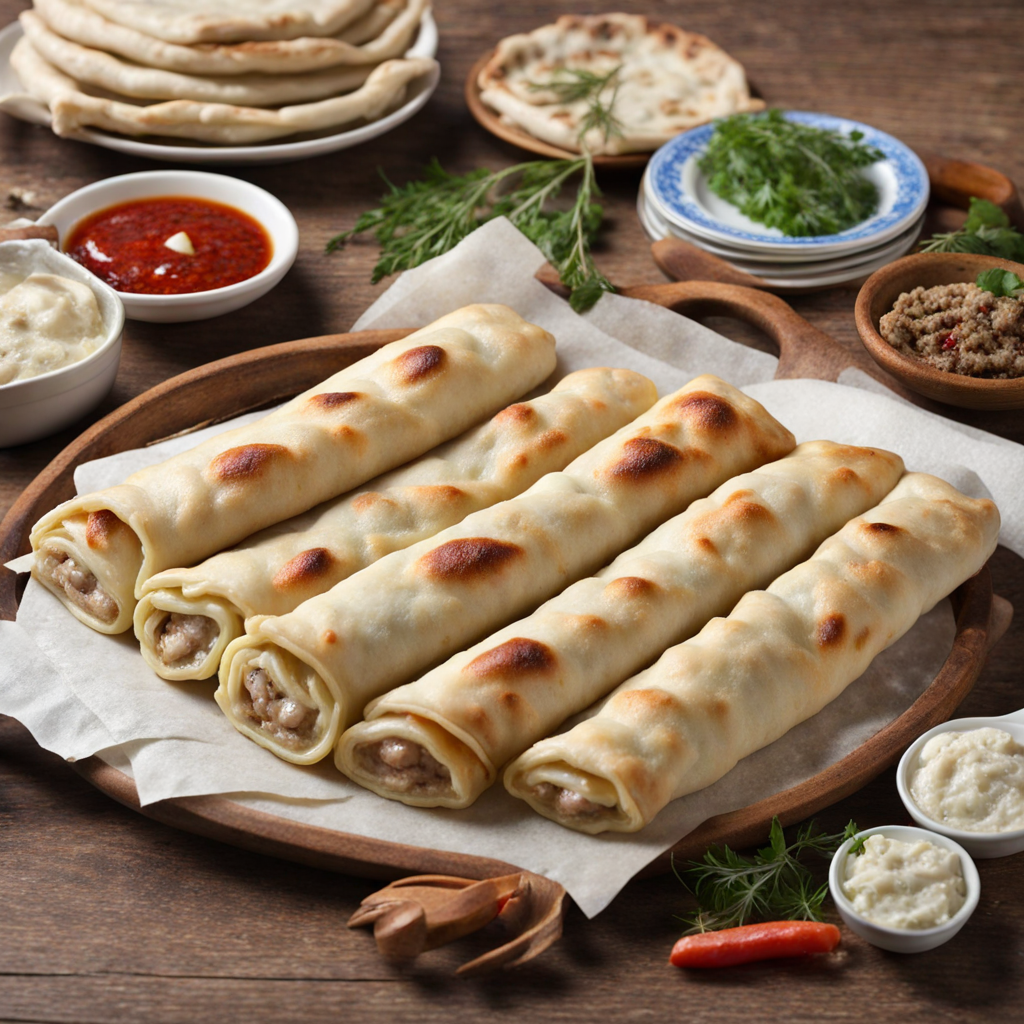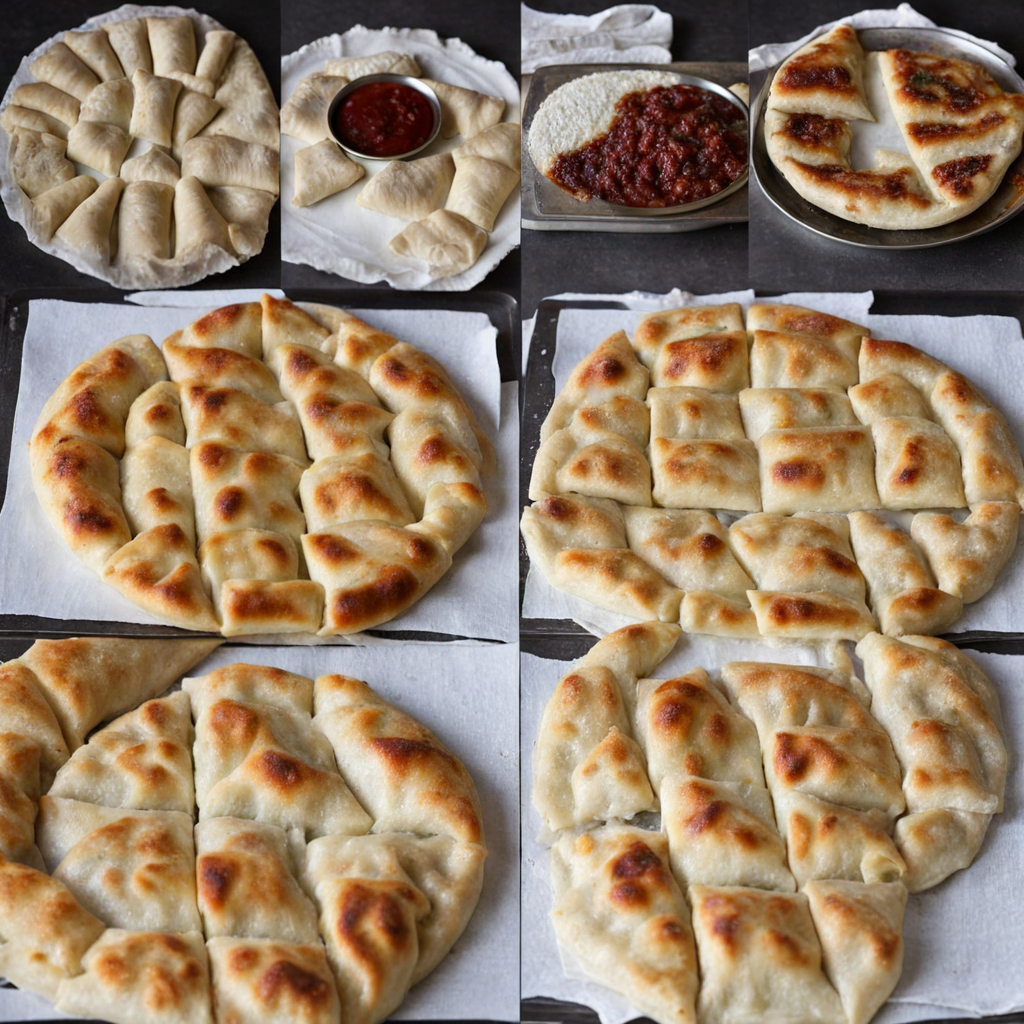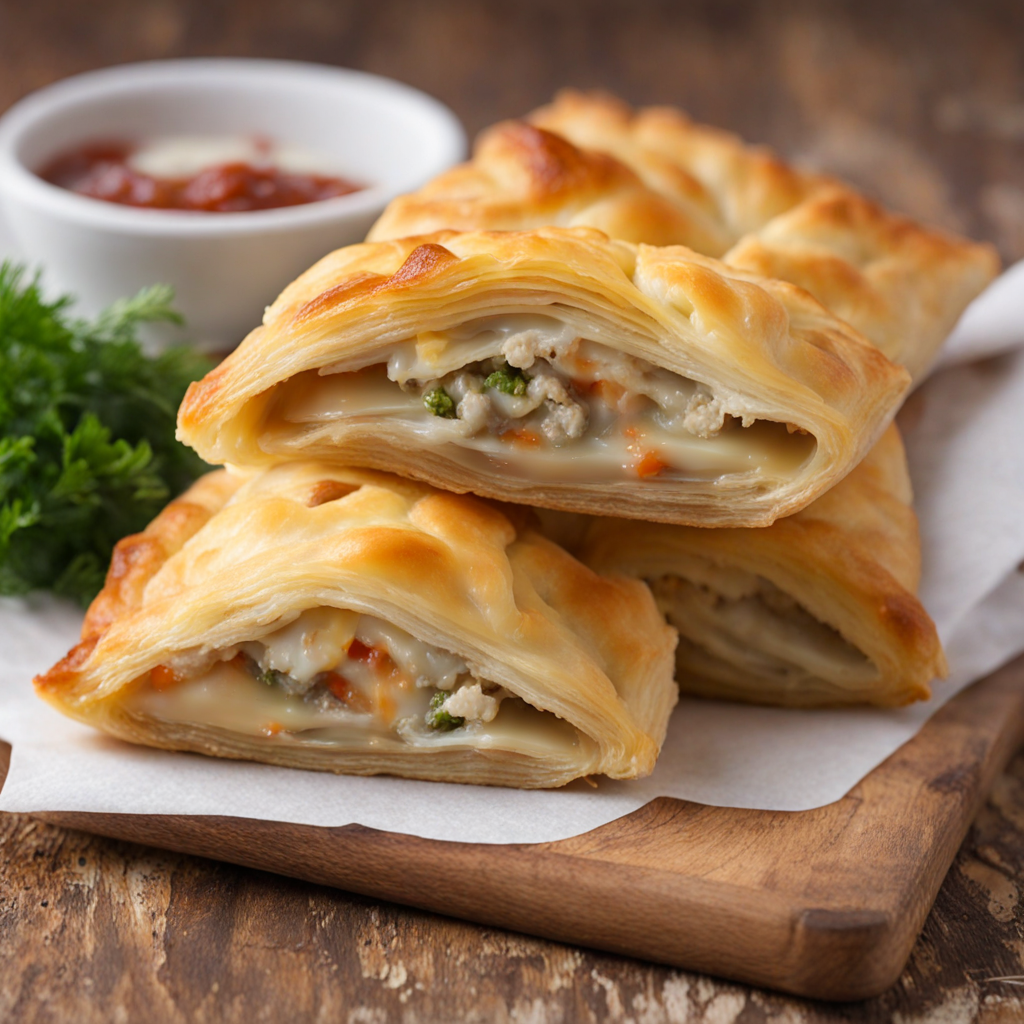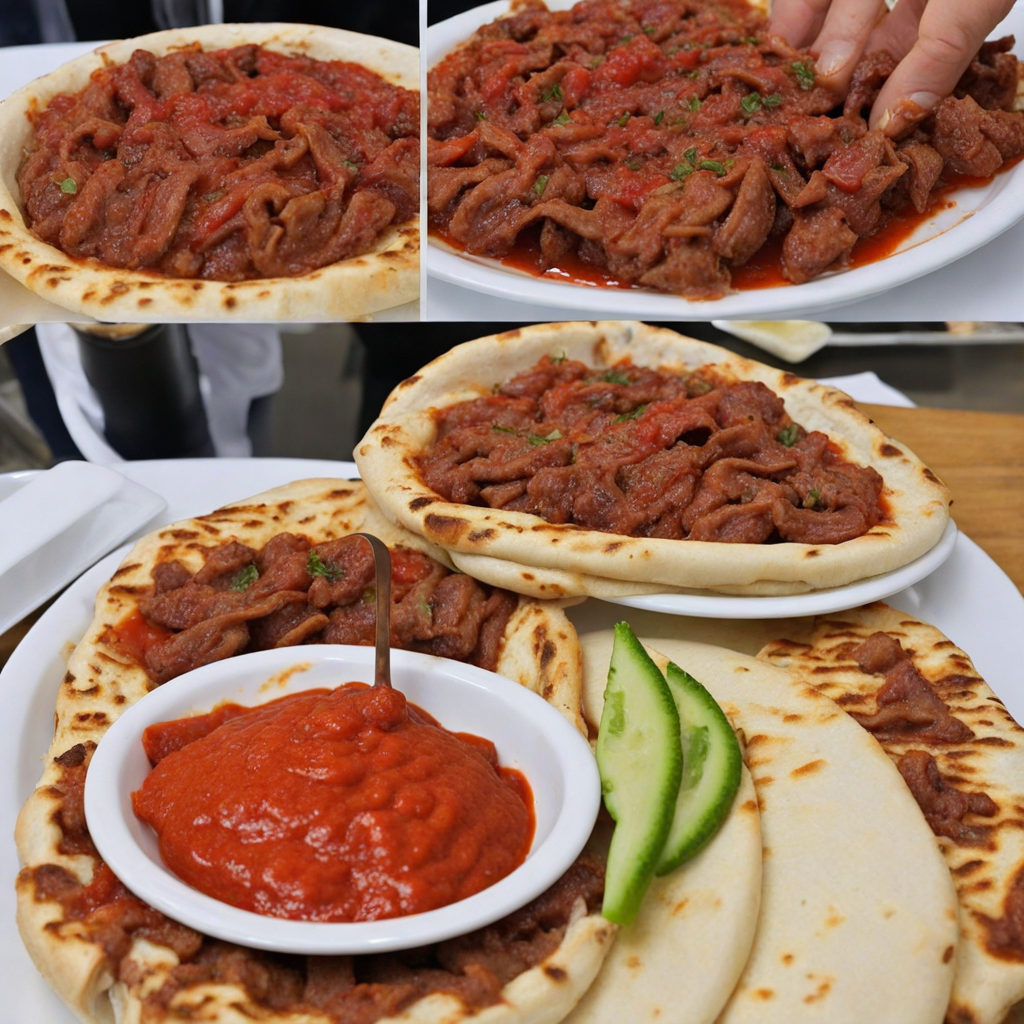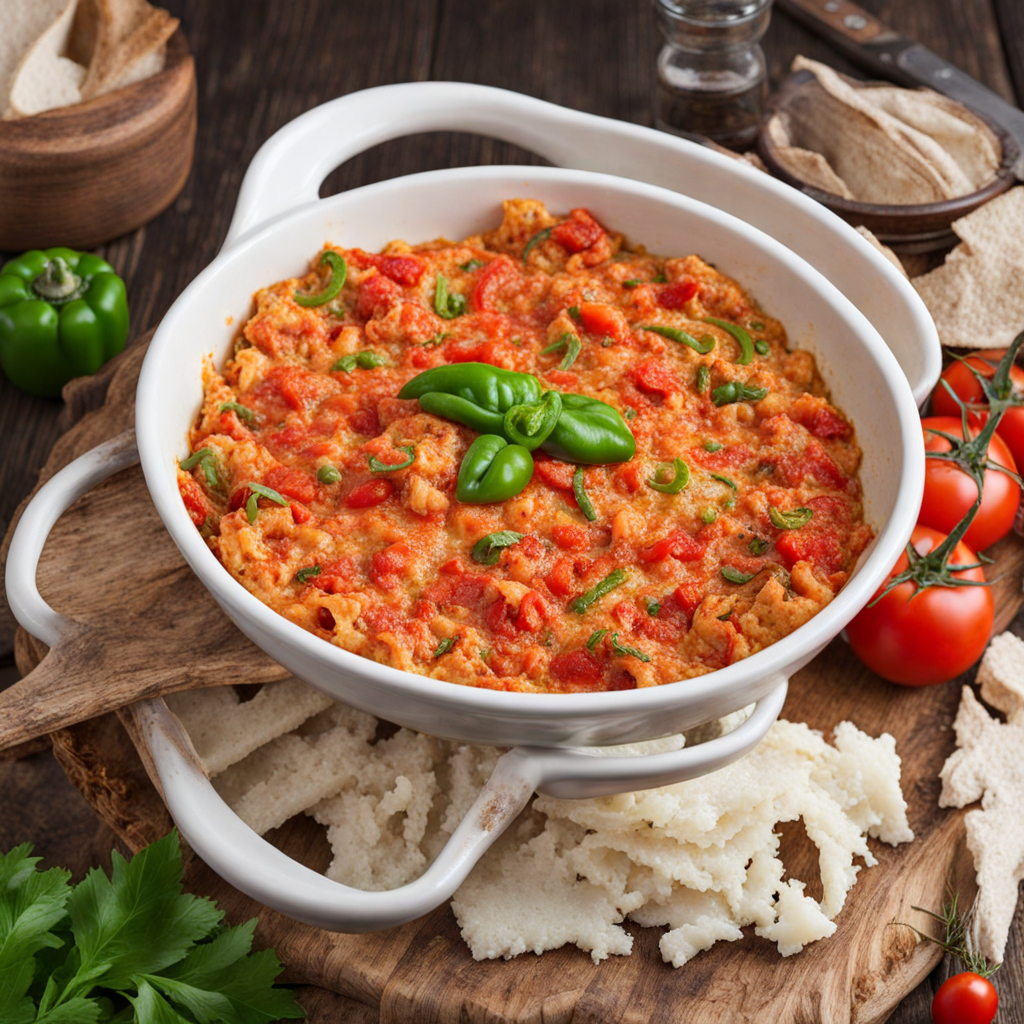Gözleme
Gözleme is a traditional Turkish dish that embodies the essence of rustic cooking with its simple yet flavorful ingredients. This delightful treat consists of thin, hand-rolled dough that is filled with a variety of ingredients, including spinach, feta cheese, minced meat, or potatoes, and then sealed and cooked on a griddle. The dough is made from flour, water, and salt, resulting in a soft and pliable base that crisps beautifully when cooked. Each bite offers a satisfying contrast between the crunchy exterior and the warm, savory filling, making it a perfect snack or meal option for any time of day. What makes Gözleme particularly appealing is its versatility; it can be customized to suit various tastes and dietary preferences. The fillings can range from classic combinations like spinach and cheese to more inventive mixtures featuring herbs, spices, and even seasonal vegetables. This adaptability allows Gözleme to cater to a wide audience, from meat lovers to vegetarians, ensuring that everyone can enjoy its delicious flavors. Additionally, the dish is often served with a side of yogurt or a tangy salad, enhancing the overall experience by adding freshness and creaminess. The preparation of Gözleme is often a communal activity, traditionally made by families or friends, emphasizing the importance of togetherness in Turkish culture. Street vendors and local eateries frequently serve this dish, and the sight of the dough being expertly rolled out and filled is a captivating experience. Whether enjoyed at a bustling market or in the comfort of home, Gözleme offers a unique taste of Turkey that invites you to savor the rich culinary heritage of the region, making it a must-try for any adventurous food lover.
How It Became This Dish
Gözleme: A Culinary Journey Through Time and Culture Gözleme, a beloved traditional Turkish flatbread, is more than just a delicious snack; it is a dish steeped in history and cultural significance. As one delves into the origins of gözleme, it becomes clear that it reflects the rich tapestry of Turkish culinary practices, regional variations, and the enduring spirit of communal eating. #### Origins of Gözleme The roots of gözleme can be traced back to the nomadic Turkic peoples of Central Asia, who traveled with their livestock and utilized available grains to create simple yet nourishing meals. The name "gözleme" is derived from the Turkish word “göz,” meaning “eye,” referring to the small pockets or “eyes” that form when the dough is folded over the filling and cooked. This flatbread is traditionally made from simple ingredients: flour, water, and salt, which are combined to form a pliable dough, rolled out, filled, and then cooked on a griddle. As the Turkic tribes migrated westward into Anatolia, their culinary practices evolved, influenced by the diverse cultures they encountered. The introduction of various fillings—ranging from spinach and feta to minced meat—reflected local agricultural practices and available ingredients, leading to the rich variety of gözleme we see today. #### Cultural Significance Gözleme holds a special place in Turkish culture, often associated with communal gatherings, street food, and family celebrations. It is commonly prepared during festivals, picnics, and family gatherings, serving as a food that brings people together. Street vendors, known as "gözlemeci," can be found in bustling markets and at fairs, where they skillfully prepare gözleme on large, flat griddles, enticing passersby with the aroma of sizzling dough. In Turkish cuisine, gözleme is much more than a meal; it symbolizes hospitality and warmth. It is often served with a side of yogurt or a salad, making it a complete dish that showcases the balance of flavors and textures that Turkish cuisine is renowned for. The act of preparing gözleme can also be a social event, as family members gather to roll out the dough, assemble fillings, and cook together, reinforcing bonds and traditions. #### Development Over Time As Turkey underwent significant historical changes—from the rise and fall of empires to the impact of globalization—so too did gözleme. The Ottoman Empire, in particular, played a crucial role in shaping Turkish culinary practices. The empire's vast expanse and cultural diversity contributed to an array of filling ingredients and cooking methods. Gözleme became prevalent in palace kitchens, where chefs experimented with flavors and presentations, elevating the dish's status. In the 20th century, with the advent of modernity and urbanization, gözleme began to transition from a home-cooked meal to a popular street food. As urban centers grew, so did the number of street vendors, making gözleme accessible to a wider audience. The simplicity and portability of the dish made it an ideal choice for people on the go, leading to its status as a quintessential Turkish snack. The rise of tourism in Turkey, particularly in the late 20th and early 21st centuries, also contributed to the popularity of gözleme beyond Turkey's borders. Travelers seeking authentic culinary experiences discovered the dish at local markets and eateries, helping to globalize its appeal. Today, gözleme can be found in Turkish restaurants worldwide, often served in various forms and adaptations, reflecting local tastes while retaining its traditional essence. #### Regional Variations One of the fascinating aspects of gözleme is its regional diversity. Different regions of Turkey have their own unique takes on this flatbread, influenced by local ingredients and culinary traditions. For instance, in the Black Sea region, gözleme is often filled with a mixture of local herbs and cheeses, creating a fragrant and flavorful dish. In contrast, the southeastern regions may offer gözleme filled with spiced minced meat, reflecting the area's rich culinary heritage. Moreover, the filling options have expanded over time. While traditional fillings like spinach and cheese or minced meat remain popular, contemporary variations include everything from sweet fillings of Nutella and banana to vegetarian options featuring lentils and seasonal vegetables. This adaptability speaks to gözleme's enduring popularity, as it evolves to meet the tastes and preferences of modern diners while keeping its traditional roots intact. #### Modern-Day Gözleme In contemporary Turkey, gözleme continues to thrive as a beloved street food and a staple in households. Artisanal gözleme shops have emerged, where chefs take pride in their craft, using high-quality ingredients and traditional cooking methods. Some establishments even invite customers to observe the cooking process, further enhancing the communal aspect of this dish. Social media has also played a significant role in the resurgence of gözleme's popularity. Food bloggers and influencers showcase the dish, sharing recipes and cooking techniques, thus fostering a renewed interest among younger generations. The dish’s photogenic quality, with its golden, flaky exterior and vibrant fillings, makes it a favorite for food photography, capturing the hearts and appetites of a global audience. Gözleme's presence at food festivals and culinary events has also contributed to its continued relevance. Chefs experiment with innovative fillings and presentations, pushing the boundaries of traditional gözleme while honoring its heritage. This blend of tradition and innovation ensures that gözleme remains a dynamic part of Turkey's culinary landscape. #### Conclusion Gözleme is not just a dish; it is a testament to the resilience and adaptability of Turkish cuisine. From its nomadic origins to its modern-day interpretations, gözleme reflects the richness of Turkey's culinary heritage and the cultural significance of food as a means of connection. Whether enjoyed at a bustling market or prepared lovingly at home, gözleme continues to bring people together, celebrating the joys of shared meals and the stories that accompany them. As it evolves with time, gözleme remains a cherished symbol of Turkish identity, embodying the flavors, traditions, and communal spirit that define this vibrant culture.
You may like
Discover local flavors from Turkey


